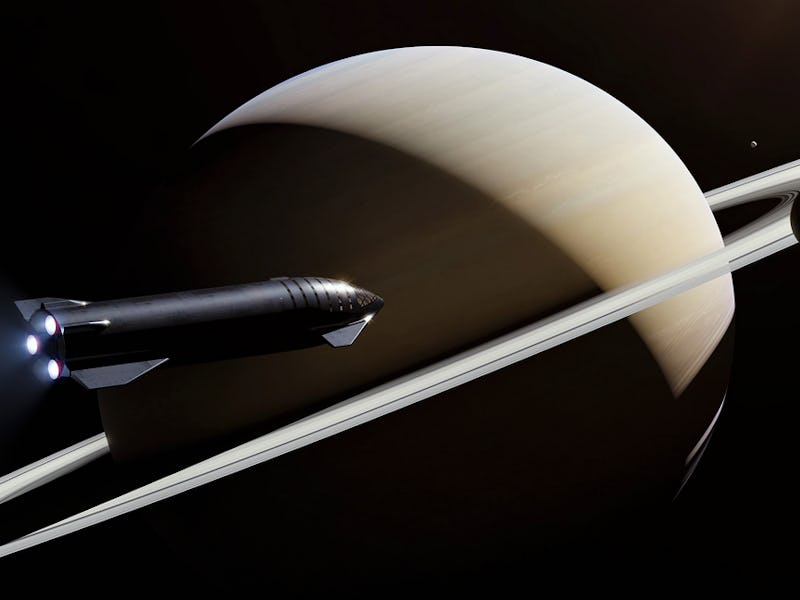SpaceX: Elon Musk explains how Mars city will make humanity interstellar
SpaceX CEO Elon Musk has big plans to send humanity to the Moon, Mars, and beyond.

Humanity needs to prepare to go interstellar before it’s too late, Elon Musk explained last week.
On Wednesday, the SpaceX CEO explained on Twitter how the spaceflight firm’s latest launch would help humanity protect Earth against asteroids. The long-term goal, however, is to build a self-sustaining city on Mars that would ensure humanity’s survival in case of a catastrophe on Earth.
“If we are able to make life self-sustaining on Mars, we will have passed one of the greatest filters,” Musk wrote. “That then sets us up to become interstellar.”
The comments come after SpaceX launched NASA’s Double Asteroid Redirection Test (DART). The mission launched on November 23 at 10:21 p.m. Pacific time from Space Launch Complex 4 East at Vandenberg Space Force Base in California.
NASA bills it as “humanity’s first planetary defense test mission,” and the goal is to see whether crashing a spacecraft into an asteroid could change its course. The target is the smaller of the Didymos binary asteroids, measuring 160 meters (524 feet) across. DART will strike the moonlet in September 2022, around 11 million kilometers (seven million miles) from Earth at a speed of 6.6 kilometers per second (14,764 mph).
Want to find out more about SpaceX’s plans to transform humanity into a multi-planet species? Subscribe to MUSK READS+ for exclusive interviews and analysis about spaceflight, electric cars, and more.
For Musk, the mission shows the fragile nature of life on Earth.
“This will be really important one day. Much is made of meteor impacts that destroyed most life on Earth, but there were far more that ‘merely’ destroyed a continent. Comets (not asteroids) are the real wild card, as we’re only able to track ~4600 out of ~1 trillion.”
SpaceX's DART mission for NASA lifts off into the sky.
If we don’t act fast, Musk explained, humanity could run out of time.
“Earth is ~4.5B years old, but life is still not multiplanetary and it is extremely uncertain how much time is left to become so,” Musk wrote.
The plan is part of SpaceX’s long-term goal to transform humanity into a multi-planet species. It starts with the Starship, a fully-reusable rocket currently under development in Texas. It’s capable of sending over 100 people or 100 tons to space at a time. SpaceX aims to host the first orbital flight sometime in 2022.
From there, the goal is to send the first humans to Mars at some point in the 2020s. This will be the first step toward establishing a full-size city of 1 million people on Mars by 2050. Musk’s goal is for the city to be self-sustaining, so if regular supplies from Earth stopped one day, the city could still function.
It’s an ambitious goal, but Musk isn’t stopping there.
SpaceX Mars city: What is the Great Filter?
Musk aims to move humanity beyond what’s known as the “great filter.”
For background, Musk is talking about an answer to the Fermi Paradox. That paradox, coined by nuclear physicist Enrico Fermi, asks why we haven’t seen any evidence of extraterrestrial life if it’s so common in the universe. In other words, where is everybody?
The term “great filter,” coined by economist Robin Hanson, tries to provide an answer. It suggests that maybe something stops civilizations from reaching a life stage that can explore the stars. Either humanity has moved past it — that’s good news — or it’s still to come, in which case we might not explore the stars.
Musk suggests that one of the great filters — he prefers to use the plural — could be the inability to become multiplanetary. Move past that hurdle, and humanity may have overcome one of the most significant barriers to achieving an advanced stage of development.
SpaceX concept art for a Mars city.
SpaceX Mars city: How will it help humanity become interstellar?
Humanity probably won’t reach another star in Musk’s lifetime. His long-term goal is to establish the Mars city, which could then pave the way for further advancements.
SpaceX designed Starship for full reusability and refueling using in-space resource utilization. Its liquid oxygen and methane fuel means humans could refuel using MMars’resources and either return to Earth or venture out further, establishing a planet-hopping network along the way.
The ship won’t take humanity to other stars, but Musk suggests that establishing a second home for humans would increase the chances of reaching other stars in the far future. It would mean that if a catastrophe wipes out humanity on Earth, work could continue on the Mars base or any other established settlements.
Hopefully, NASA’s DART mission means that such a backup becomes unnecessary.
SUBSCRIBE TO MUSK READS+, A PREMIUM NEWSLETTER THAT COVERS THE WORLDS OF ELON MUSK, SPACEX, TESLA, AND EVERYTHING BETWEEN.